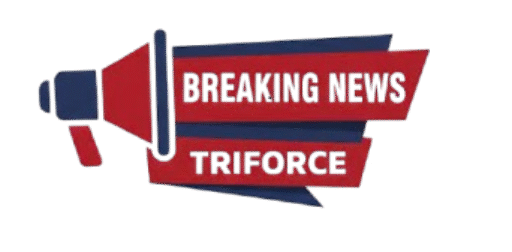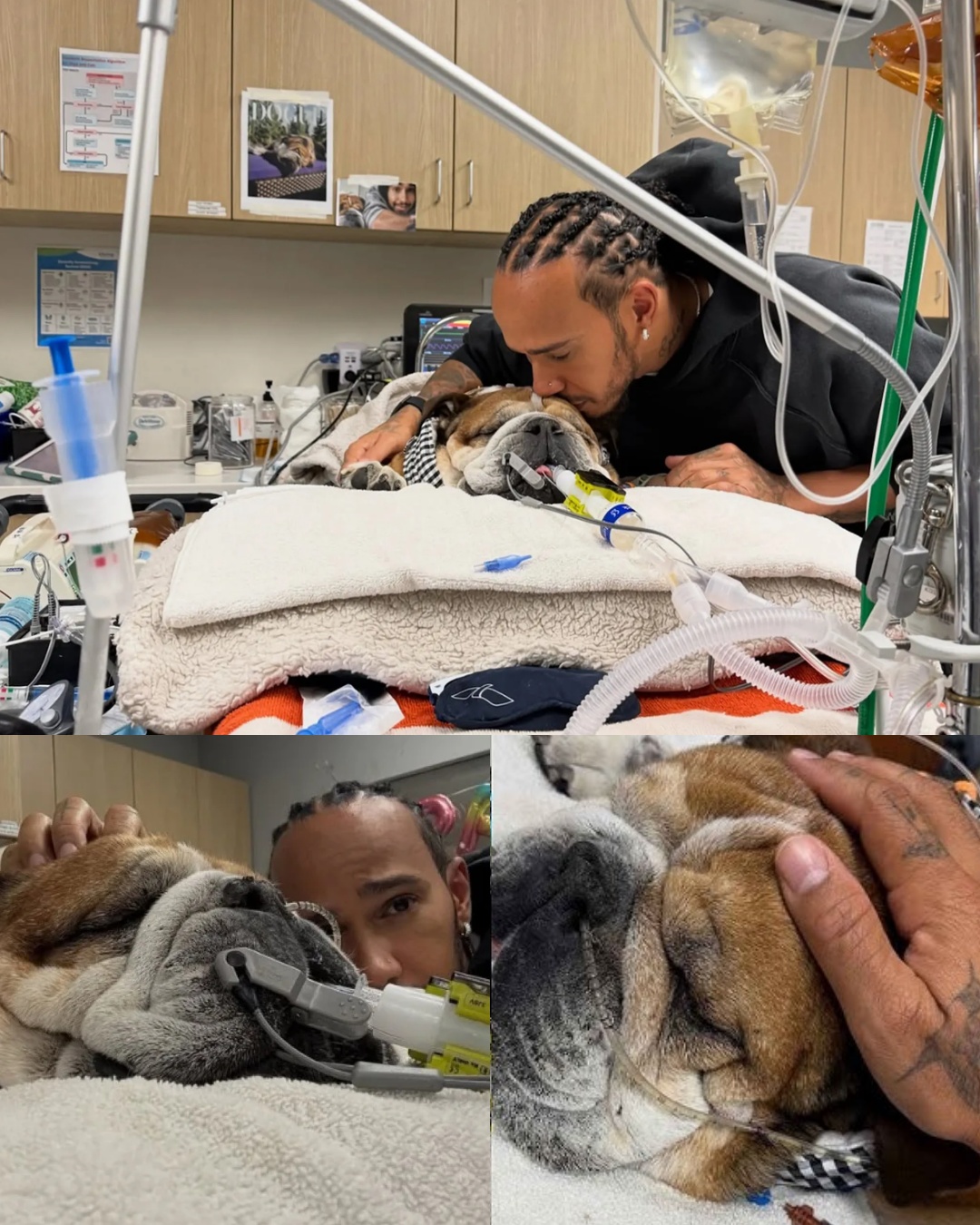The world of Formula 1 is often defined by speed, adrenaline, and the relentless pursuit of victory.

But away from the roaring engines and flashing cameras, there are moments that remind us that even champions face battles of the heart.
For Lewis Hamilton, the seven-time Formula 1 World Champion, that battle now has a name—Roscoe.
Roscoe is not a rival on the track, nor a teammate in the garage.
He is a 12-year-old bulldog.
A loyal companion.
A presence that has walked with Hamilton through triumphs and setbacks, through the highs of podiums and the lows of defeats.
Fans know Roscoe well.
The bulldog has often appeared alongside Hamilton, with his signature bow-legged strut and unmistakable charm.
On social media, Roscoe became more than just a pet—he became family, a symbol of joy and grounding in the whirlwind of a superstar’s life.
But now, Roscoe’s story has taken a heartbreaking turn.
Earlier this week, the bulldog suffered a relapse of pneumonia.
The illness had already tested his strength before, but this time, it returned with a vengeance.
Struggling to breathe, Roscoe was admitted to a veterinary clinic.
Hamilton stayed close, his heart heavy as he watched his best friend fight for air.
During the medical tests, tragedy struck.
Roscoe went into cardiac arrest.
For a moment, the world seemed to stop.
Machines beeped.
Veterinarians rushed.
Hands pressed, air pumped, hope flickered.
Then—miraculously—they managed to restore his heartbeat.
But Roscoe did not wake.
He slipped into a coma, his small body still, his fate uncertain.
Hamilton, shaken but steadfast, turned to his fans and followers.
“Please keep Roscoe in your thoughts,” he wrote.
His words carried both fear and faith, a plea from a man used to controlling everything on the track but powerless in the face of life’s fragility.
“We don’t know if he will wake up,” he admitted.
“Tomorrow, we will attempt to wake him. I am by his side and want to thank everyone for their prayers and support.”
It was a message that rippled across the world.
Fans who cheered Hamilton’s victories now gathered in a different kind of support—sharing prayers, well wishes, and memories of the bulldog they had come to love from afar.
Because Roscoe was never just a pet in the background.
He was a companion in the spotlight.
He was there in the paddock, in hotel rooms, on long flights, bringing comfort and laughter to a man carrying the weight of a global sport.
Roscoe had his own personality, his quirks, his charm that captivated millions.
And now, he was in a fight for his life.
For Hamilton, this was no different than standing on the edge of victory or defeat.
The stakes were just as high, if not higher.
Because this was family.
This was love.
This was a bond built not on trophies or titles, but on the simple joy of walking side by side.
As the hours stretched into the night, Hamilton remained at Roscoe’s side.
He whispered to him, stroked his fur, reminding him he was not alone.
The monitors hummed, the clinic lights glowed softly, and hope lingered in the room.
For all his victories on the track, this was the battle that mattered most.
And like millions of others who have watched their beloved animals fight for life, Hamilton knew the helplessness of waiting, the agony of uncertainty, the desperate prayer for one more wag of the tail.
The story of Roscoe is not just about a bulldog.
It is about love unmeasured by fame, about devotion that ignores wealth, about the reminder that even the strongest among us need their companions to make life whole.
For fans, for animal lovers, for anyone who has ever sat by a hospital bed—human or animal—Roscoe’s fight is familiar.
It is a reminder of how fragile life is.
Of how quickly everything can change.
And of how the love between a man and his dog can be as profound as any bond.
As Hamilton waits, surrounded by prayers and hope, Roscoe fights quietly in his coma.
Tomorrow, they will try to wake him.
And tomorrow, the world will hold its breath with them.
Because for once, the race is not against other drivers, or against the clock.
It is against time itself.
Against illness.
Against fate.
And it is fought not with tires and engines, but with love, resilience, and faith.
“When Seconds Count: Brian and Debbie’s Story of Survival”.1576
A Summer Ride That Changed Everything
In late July, Brian and Debbie Haynes set out on their motorcycle for what was supposed to be an ordinary ride near Orillia, Ontario. The couple loved riding together — the freedom of the open road, the wind rushing past, the feeling of adventure they always shared. It was part of who they were as partners, companions, and friends.
But in a single, devastating instant, everything changed.
A collision with an oncoming vehicle left them both critically injured. In the chaotic aftermath, sirens and flashing lights replaced the hum of their bike. Emergency responders rushed to stabilize them on the roadside, knowing immediately that the situation was life-threatening.

Both Brian and Debbie were airlifted by Ornge to Sunnybrook Health Sciences Centre in Toronto. The helicopter ride was not only a matter of speed — it was a matter of survival. Every second counted.
The Race Against Time
At Sunnybrook, the Tory Trauma Program — one of the busiest and most advanced trauma programs in Canada — was ready. Teams of surgeons, nurses, and specialists were already preparing as the helicopters landed.
Brian and Debbie arrived just minutes apart. Both were immediately assessed, scanned, and stabilized. Their injuries were catastrophic, and both required rapid, decisive action.
In the days that followed, they each underwent multiple surgeries. Despite the best efforts of their trauma and surgical teams, both Brian and Debbie ultimately lost their left legs as a result of the collision.
The Aftermath of Trauma
For any patient, the loss of a limb is overwhelming. For Brian and Debbie, it was doubly so — each of them enduring not only their own pain and fear but also worrying for the other.
Recovery meant learning to navigate a completely different reality. Simple things, once taken for granted, became new challenges: standing, walking, even imagining life outside the hospital.

But they were not alone. The trauma teams, rehabilitation specialists, and nurses at Sunnybrook surrounded them with support. Every step of the way, they worked to stabilize their health, manage their pain, and help them begin the long journey of recovery.
The Human Side of Care
What makes trauma care at Sunnybrook extraordinary is not only the advanced medicine but also the compassion. Staff members became more than healthcare providers — they became partners in Brian and Debbie’s recovery.
Rehabilitation specialists introduced them to the possibilities of prosthetics. Psychologists and social workers helped them process the grief of sudden loss and imagine a future that, though different, could still hold meaning and joy.
Family and friends rallied around them too. Messages poured in, visits lifted spirits, and the couple found strength not only in each other but also in the wider community that surrounded them with love.
The Larger Picture
Stories like Brian and Debbie’s are why Sunnybrook is working toward building a new Critical Care Centre. Trauma, like cancer or heart disease, requires resources that are fast, flexible, and future-focused.
The proposed centre is designed to transform how critical care is delivered across Ontario. It will bring together trauma, surgery, intensive care, and rehabilitation under one roof — ensuring that when accidents like Brian and Debbie’s happen, there is a system ready to respond immediately and comprehensively.
Each year, Sunnybrook treats thousands of patients with life-threatening injuries. Some arrive by ambulance, others by helicopter. Each story is unique, but all have one thing in common: the need for a hospital that is ready 24/7, no matter what.
Finding Strength Together
Brian and Debbie’s story is one of resilience. Though the accident forever changed their lives, it also revealed their strength, their love for one another, and the importance of having access to world-class trauma care when it matters most.
Today, they are navigating rehabilitation and adjusting to life with prosthetics. They know the road ahead will not be easy, but they also know they are not walking it alone.
They are living proof of what it means to survive the unimaginable — and what is possible when care, compassion, and expertise come together in the moments that matter most.
Why Their Story Matters
Accidents happen in the blink of an eye. No one plans for them, no one expects them. But when they do happen, the response makes all the difference.
For Brian and Debbie, Sunnybrook was that difference. From the helicopter landing pad to the trauma bay, from the ICU to rehabilitation, every part of the system worked together to give them the best chance of survival and recovery.
Their story is also a reminder of why investment in trauma and critical care matters — because every patient deserves the same chance to come home, to rebuild, and to hope again.
Closing Reflections
The summer ride that began with laughter ended in tragedy, but it also became a story of survival. Brian and Debbie lost much that day, but they also gained a new perspective, a new community, and a renewed sense of resilience.
And through their story, Sunnybrook continues to show why it matters — not just as a hospital, but as a lifeline for families across Ontario.
When seconds count, when the unthinkable happens, when lives hang in the balance — Sunnybrook is there.




